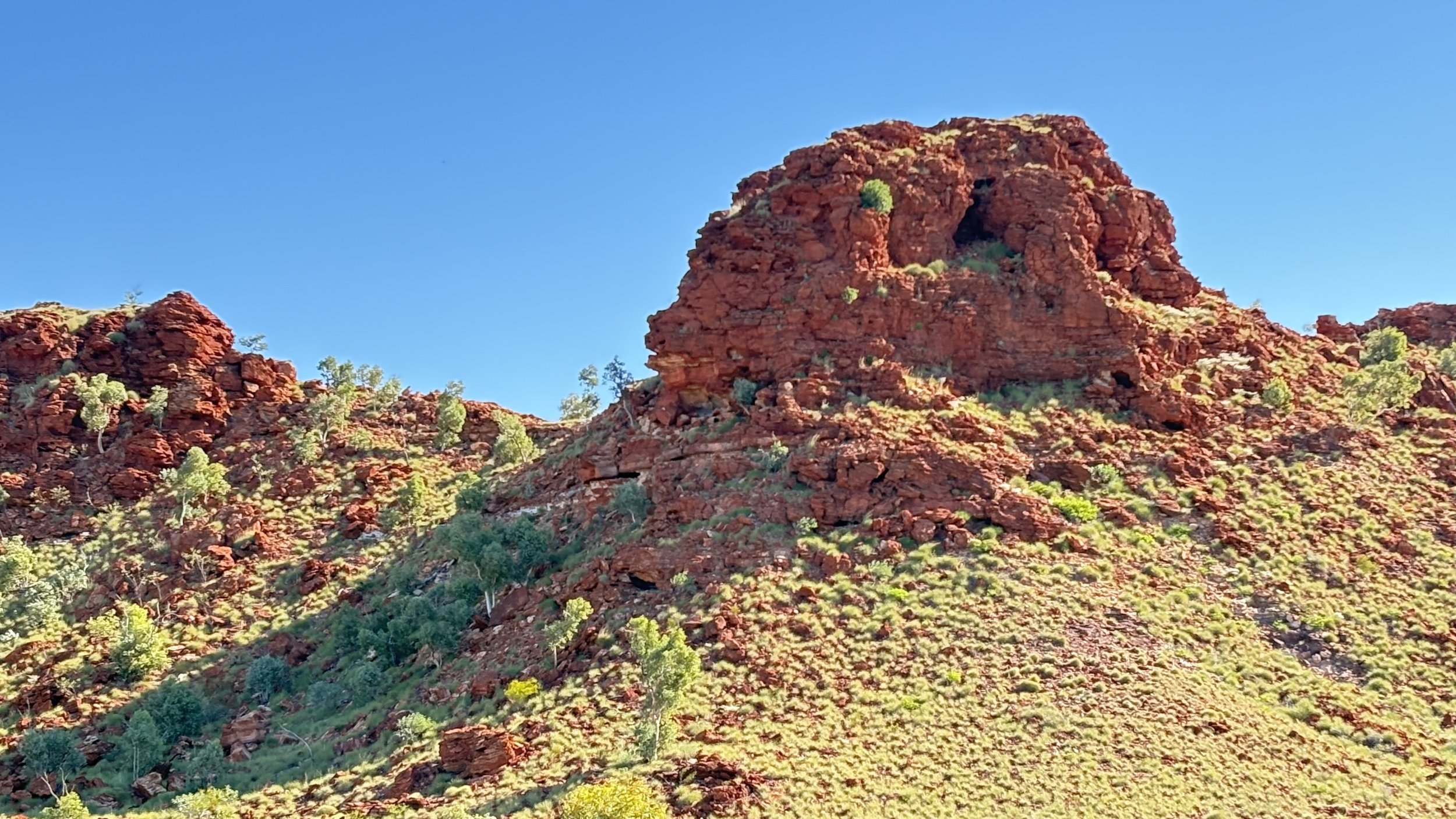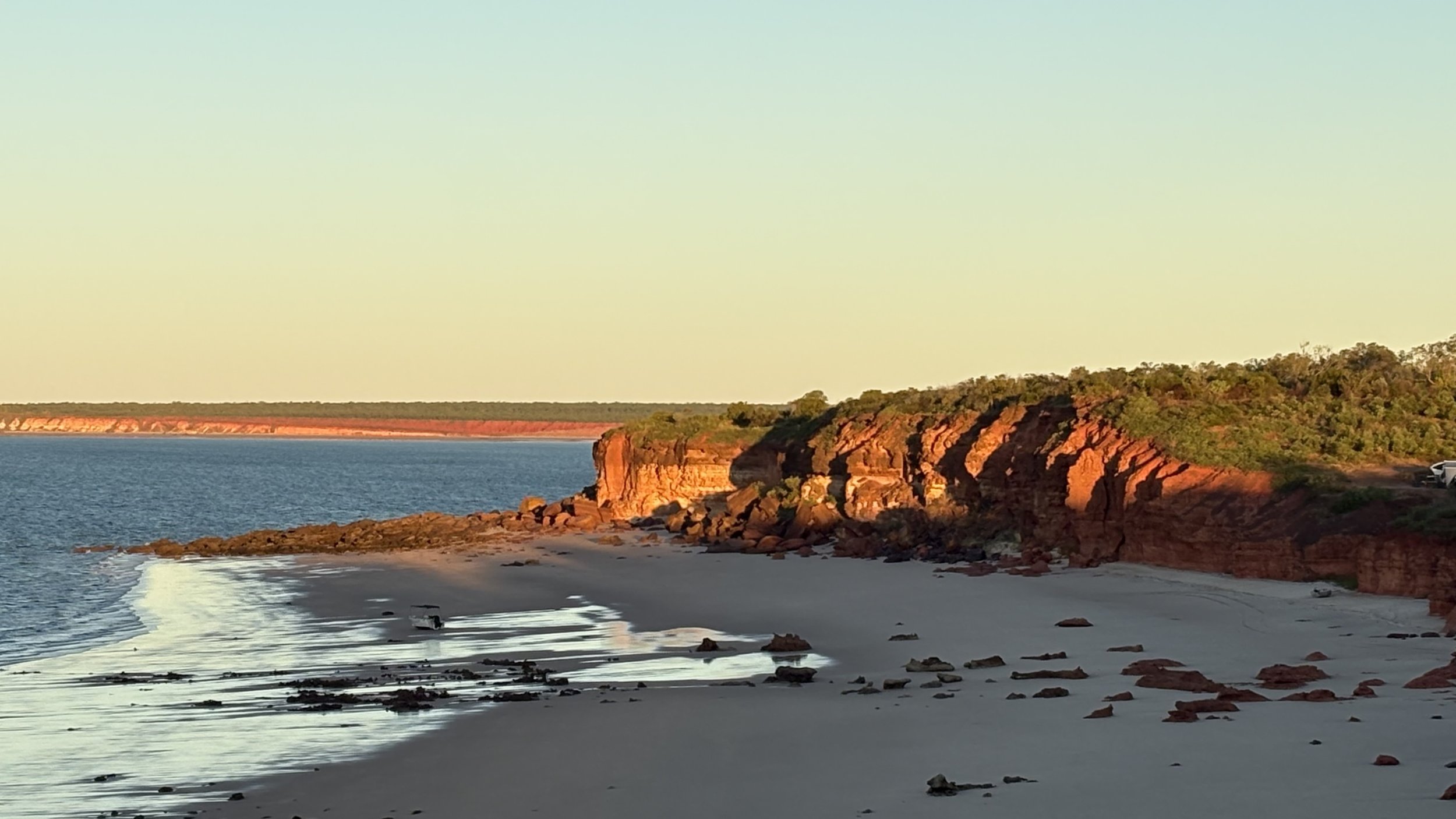Week 15 dodging the deluge on our way to Broome
We hear along the camper grapevine (aka campvine) that 900 millimetres of rain is coming to the Kimberley. While our camp set up is perfect for sunshine, it’s not designed for deluges or the angry red modelling of some weather forecasters. Cousin Trish has also messaged me a Facebook post about the rain brewing to the north of the Kimberley. With endless dirt roads, we’ll need to rethink our plans and stick to the bitumen. We check the weather continuously over the next few days, comparing BOM, Elders and Windy for the most up-to-date information.
In the meantime, we make our way from Millstream to Broome and it’s a long drive. We leave our secluded spot on George River and head for the Cove Caravan Park at Point Sampson, recommended by Fran and Craig. They also tell us that Regurgitator is playing nearby.
Heading to the ‘Gurg gig at the Wickham Yacht Club, we drive through another imposing industrial landscape: over bridges, beside rail lines, between bare hills as the sun sinks lower in the sky. We skirt the edge of the port with cranes, ships, docks and trucks and more bridges on roads built for mining. A reminder that while we might drive for hours and hundreds of kilometres without seeing another person, there’s a thriving industry here. The trains arrive full and leave empty.
It’s a bit of a surprise to see Regurgitator in a small town, at a gig sponsored by Rio Tinto. They are playing as part of a local festival in the Karratha area.
At the gig I enjoy my fish and chips while Jeremy eats the only other option available, nuggets and some of my chips. Definitely not a food destination. The band are a lot of fun, amping up the very small crowd, making fun of themselves and everyone else, including the mines.
Back at camp, there’s another issue: the back door on the Prado isn’t closing. A job for the morning before checkout.
The next day after Jeremy fixes the door, as we pull out of the caravan park, he notices a lot of space around one of the trailer tyres. Maybe we could get some juicy mags for the trailer? As he walks to the other side, he sees that there’s no space in that wheel hub. Checking underneath, the axle has somehow slipped sideways and backwards about five centimetres, even bending the U-bolts. Fortunately he didn’t notice this when we were far away from services.
To our great surprise, Corey from Pilbara Coast Mechanicals fixes it within a few hours and we’re back on the road by early afternoon. Normally we’re told, “Not a chance, mate. Booked solid for a month.”
Thank you Corey.
The next few days sees us skipping up the coast, stopping at our second highway roadside camp, Sherlock River. While beautiful, it is noisy with trucks rumbling by. We won’t be doing that again.
Port Hedland is another education, with more rumbling road trains and dust and ships. This is industry on a scale I haven’t seen elsewhere.
The most interesting place we find on our drive through is Spinifex Hill Studio in South Hedland, where we see some Indigenous art, then on to the butcher, a grocery shop and, having felt the pinch of a few cooler evenings, we make a mad dash to K-Mart for some cheap winter wares. Not easy to find when average winter daytime temps are 30 degrees.
Between Pardoo Station stay and 80 Mile Caravan Beach Caravan Park we detour to abandoned mining town Shay Gap. There’s the disused rail line beside hillsides patterned as though tractor buckets have systematically lumped earth on the slopes. There are spinifex and other plants dotted across the mounds – maybe an attempt at rehabilitation.
About 180 km south of Broome we pop into Bidydanga Aboriginal Community, the largest remote Aboriginal community cafe where we chat with some of the workers in the Art Centre and Edward, one of the artists. It's great to meet the locals.
The car is scheduled for a service in Broome giving us time to enjoy a town breakfast and coffee at a very busy Short St Café. The plaques around town tell the history of blackbirding and the pearling industry, with bronze statues commemorating some of the founders, along with an information walk. I’m surprised that we still celebrate an industry and people who promoted the brutality of blackbirding. How would I have responded fifty or a hundred years ago? It is easy to judge in hindsight, I suppose.
We catch up with Fran and Craig at Cable Beach, watch the sunset and have dinner at the Spinifex Brewery. Before heading out of town we go to the Broome Courthouse markets, where I buy Jandamarra and the Bunubu Resistance by Banjo Woorunmarra and Howard Pederson, an account of Aboriginal resistance in the late 19th century in the Kimberley.
And we’re still on the mining superhighway. Not only are there still a heap of road trains, we see huge helicopters at the airport which transport workers out to the gas rigs, about two hours by chopper offshore.
Just ahead of the rain, and after a night of beach camping at the beautiful Barred Creek, we arrive at Lombadina with its tidy, enclosed camp kitchen to wait out the rain. It’s an Aboriginal community that used to be a Catholic mission. There is a school here and I have a lovely yarn on one of our rainy mornings with community elder, Aunty Caroline who simply shakes her head at the state of the nation.
The rain clears after a couple of days and we head down to Pender Bay Escape in the sunshine through the 109 puddles along the 40 km of dirt. We spent three nights perched on the cliffs above the ocean, with a bathtub and running water.
Getting in, though, with so many large puddles on the road, is a bit nerve racking. We stop at the first hole of water on the track behind another traveller. We can’t actually see where it ends. Or how deep it is. But after 17,000 kilometres of our overlanding education, we’re prepared to give it a crack. After a couple of minutes, a white Hilux comes along and floors it through. We marvel and watch the water fan off to the sides of the vehicle, deciding that if they’re ok, we’ll be ok too.
When we arrive, custodian Andrew, spends an hour chatting with us, sharing the reality of native title for Aboriginal people, particularly as there are usually more than two groups involved. He explains there’s no option to say no to development or mines, for example; traditional owners can only negotiate. One way to protect the land and waters of his people is to find something, animal or plant, that needs protecting. Interestingly, he started filming humpback whales around eight years ago, collecting information about migration and birthing patterns, recording whale song on hydraphone, identifying the regulars who return year after year. Protecting place and people.
After the 50 millimetres of rain we copped, and Broome’s reading of 100 mm, the Gibb River Road is officially closed, as are the roads to each of the national parks along the way. This could pose a serious speedbump as we’re scheduled to meet Brodie and John at El Questro on the east end of the Gibb.
We’ll need to sit tight for a few days.

























